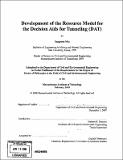| dc.contributor.advisor | Herbert H. Einstein. | en_US |
| dc.contributor.author | Min, Sangyoon, 1973- | en_US |
| dc.contributor.other | Massachusetts Institute of Technology. Dept. of Civil and Environmental Engineering. | en_US |
| dc.date.accessioned | 2008-11-07T19:10:31Z | |
| dc.date.available | 2008-11-07T19:10:31Z | |
| dc.date.copyright | 2008 | en_US |
| dc.date.issued | 2008 | en_US |
| dc.identifier.uri | http://hdl.handle.net/1721.1/43160 | |
| dc.description | Thesis (Ph. D.)--Massachusetts Institute of Technology, Dept. of Civil and Environmental Engineering, 2008. | en_US |
| dc.description | Includes bibliographical references (p. 348-353). | en_US |
| dc.description.abstract | The Decision Aids for Tunneling (DAT) are a computer based method with which distributions of tunnel construction time and cost as well as required and produced resources can be estimated considering uncertainties in geologic conditions, construction processes and resources. The results of the DAT in turn can be used for various decision making processes. Although the DAT included a resource management model, this was not at the same level as the other parts of the method. Hence, the main objectives of this research are to define the requirements for an adequate and comprehensive resource model for tunneling and develop a new resource model satisfying these new requirements. There are three major developments and contributions of the new resource models: 1. In order to have complete and accurate cost and time estimation, the new resource model can explicitly estimate the cost and time based on the actual amount of resources used for and produced from tunnel construction. 2. Resource scheduling and planning features have been implemented into the new resource model. This allows one to determine the optimal tunneling plan, which takes into account the technical precedence of the tunneling activities, the resource/space availability, the dynamic status of the process, and the work continuity. In addition, this optimal tunneling plan also satisfies the requirements for the special characteristics of the tunnel construction process such as different construction methods, cyclic operation, distance requirements between the headings and preempting activities. Most importantly, the optimal tunneling plan obtained from the new resource model optimizes resource allocation and leads to the shortest construction time. 3. The new resource model enhances the ability to represent the resource handling activities considering the locations where they are actually performed; thus the construction time can be estimated more accurately. | en_US |
| dc.description.abstract | In addition, it improves the distance-based capability so that the construction time for the resource handling activities can be estimated based on the actual travel distances of these activities. The new resource model developed in this thesis provides a new resource management model for the DAT, which allows one not only to predict and obtain the distributions of the construction time and cost with associated uncertainties and resources but also allows one to manage and schedule tunnel construction in detail to complete the project within budget and schedule. Very importantly, the new resource model can enhance the practical applicability of the DAT to actual tunnel projects by providing the tunneling plan which can be practically used in the field to plan the construction process and resource allocation most effectively. | en_US |
| dc.description.statementofresponsibility | by Sangyoon Min. | en_US |
| dc.format.extent | 353 p. | en_US |
| dc.language.iso | eng | en_US |
| dc.publisher | Massachusetts Institute of Technology | en_US |
| dc.rights | M.I.T. theses are protected by
copyright. They may be viewed from this source for any purpose, but
reproduction or distribution in any format is prohibited without written
permission. See provided URL for inquiries about permission. | en_US |
| dc.rights.uri | http://dspace.mit.edu/handle/1721.1/7582 | en_US |
| dc.subject | Civil and Environmental Engineering. | en_US |
| dc.title | Development of the resource model for the Decision Aids for Tunneling (DAT) | en_US |
| dc.type | Thesis | en_US |
| dc.description.degree | Ph.D. | en_US |
| dc.contributor.department | Massachusetts Institute of Technology. Department of Civil and Environmental Engineering | |
| dc.identifier.oclc | 248709865 | en_US |
